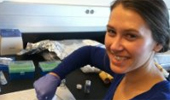Geology alum Darcy R. VanDervort ’12 and Dr. Dina López, Professor and Chair of Geological Sciences, co-authored an article in the April 2014 issue of MEDICC Review, which focused on chronic kidney disease in agricultural communities.
VanDervort, who doubled majored, did undergraduate research with López. She earned a B.S.in Environmental Geology and a B.A. in Spanish from the College of Arts & Sciences at Ohio University. VanDervort was Treasurer of Sigma Gamma Epsilon, the Geological Honor Society, and Vice President of Sigma Delta Pi, the National Collegiate Hispanic Honor Society. She received the Distinguished Professor Scholarship from Distinguished Professor of Geology, Dr. Damian Nance. She is a graduate student in Environmental Studies at the University of Arizona, where she won a Water Sustainability Fellowship Award. for 2014-15, based on her M.S. research on “Glucocorticoid Receptor Toxicity Profile of a Wastewater Effluent-Dominated Stream.”
Along with Carlos M. Orantes, M.D., and David S. Rodríguez M.D., MPH, they published on “Spatial Distribution of Unspecified Chronic Kidney Disease in El Salvador by Crop Area Cultivated and Ambient Temperature.”
ABSTRACT INTRODUCTION: Chronic kidney disease of unknown etiology is occurring in various geographic areas worldwide. Cases lack typical risk factors associated with chronic kidney disease, such as diabetes and hypertension. It is epidemic in El Salvador, Central America, where it is diagnosed with increasing frequency in young, otherwise-healthy male farmworkers. Suspected causes include agrochemical use (especially in sugarcane fields), physical heat stress, and heavy metal exposure.
OBJECTIVE: To evaluate the geographic relationship between unspecified chronic kidney disease (unCKD) and nondiabetic chronic renal failure (ndESRD) hospital admissions in El Salvador with the proximity to cultivated crops and ambient temperatures.
METHODS: Data on unCKD and ndESRD were compared with environmental variables, crop area cultivated (indicator of agrochemical use) and high ambient temperatures. Using geographically weighted regression analysis, two model sets were created using reported municipal hospital admission rates per ten thousand population for unCKD 2006–2010 and rates of ndESRD 2005–2010. These were assessed against local percent of land cultivated by crop (sugarcane, coffee, corn, cotton, sorghum, and beans) and mean maximum ambient temperature, with Moran’s indices determining data clustering. Two-dimensional geographic models illustrated parameter spatial distribution.
RESULTS: Bivariate geographically weighted regressions showed statistically significant correlations between percent area of sugarcane, corn, cotton, coffee, and bean cultivation, as well as mean maximum ambient temperature with both unCKD and ndESRD hospital admission rates. Percent area of sugarcane cultivation had greatest statistical weight (p ≤0.001; Rp2 = 0.77 for unCKD). The most statistically significant multivariate geographically weighted regression model for unCKD included percent area of sugarcane, cotton and corn cultivation (p ≤0.001; Rp2 = 0.80), while, for ndESRD, it included the percent area of sugarcane, corn, cotton and coffee cultivation (Rp2 = 0.52). Univariate unCKD and ndESRD Moran’s I (0.20 and 0.33, respectively) indicated some degree of clustering. Ambient temperature did not improve multivariate geographically-weighted regression models for unCKD or ndESRD. Local bivariate Moran’s indices with relatively high positive values and statistical significance (0.3–1.0, p ≤0.05) indicated positive clustering between unCKD hospital admission rates and percent area of sugarcane as well as cotton cultivation. The greatest positive response for clustering values did not consistently plot near the highest temperatures; there were some positive clusters in regions of lower temperatures. Clusters of ndESRD were also observed, some in areas of relatively low chronic kidney disease incidence in western El Salvador.
CONCLUSIONS: High temperatures do not appear to strongly influence occurrence of unCKDu proxies. CKDu in El Salvador may arise from proximity to agriculture to which agrochemicals are applied, especially in sugarcane cultivation. The findings of this preliminary ecological study suggest that more research is needed to assess and quantify presence of specific agrochemicals in high-CKDu areas.





















Comments